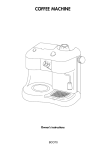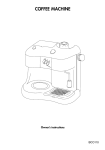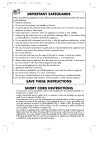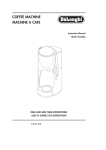Download DeLonghi BCO 65 Instruction manual
Transcript
BCO65 GB 3-07-2002 13:41 Pagina 5 ENGLISH Thank you for choosing this De’Longhi coffee machine. To get the very best out of your new coffee machine it is advisable to read these instructions before installing and using the appliance. This is the only way to ensure optimum results and maximum safety. DESCRIPTION OF THE APPLIANCE The following terms are used throughout the instruction manual. 1. Power supply cable 2. Steam exit tube 3. Steam nozzle 4. Removable drip tray 5. Boiler outlet 6. Warming plate 7. ON/OFF espresso/cappuccino switch 8. ON/OFF drip coffee switch 9. ON drip coffee light 10. ON espresso/cappuccino light 11. Small carafe for espresso/cappuccino 12. Two cup attachment for espresso coffee 13. Measuring spoon 14. Filter holder for espresso coffee 15. Filter for espresso coffee 16. Filter holder for drip coffee 17. Paper filter (if fitted) 18. Large carafe for filter coffee 19. “Flavour system” filter coffee strength selector knob 20. “Vario system” espresso coffee strength selector knob 21. Removable water reservoir 22. Lid for water reservoir 23. Steam boiler 24. Boiler cap 25. Steam release knob SAFETY WARNINGS • This machine has been built to “make coffee” and to “reheat beverages”; please be careful to avoid burns from the sprays of hot water or steam and avoid any improper use. • When the appliance is in use, do not touch any of the machine’s hot surfaces. • After unpacking, make sure that the machine is complete and undamaged. If in doubt, do not use the appliance and seek the advice of a qualified service professional. • This appliance is to be utilised for domestic use only. Any other use is to be considered improper and therefore, dangerous. • The manufacturer takes no responsibility for damage derived from improper use. • Never touch the appliance with wet or damp hands. • Never allow the appliance to be used by children or unfit persons. • In case of breakdown or malfunctioning, turn the appliance off immediately and do not touch it. For repairs, please contact a Service Centre authorised by the manufacturer. The lack of respect for this point may compromise the safe use of the appliance. • The user must never replace the power supply cable of this appliance. If the cable should become damaged, or needs to be replaced, please contact a Service Centre authorised by the manufacturer. • When the appliance is not in use, turn OFF and disconnect the plug from the socket. • As with any electrical appliance, whilst the instructions aim to cover as many eventualities as possible, caution and common sense should be applied when operating your coffee machine, particulary in the vicinity of young children. 5 BCO65 GB 3-07-2002 13:41 Pagina 6 INSTALLATION HOW TO PREPARE FILTER (DRIP) COFFEE • Place the appliance on a flat work surface at a safe distance from taps and sinks. • Raise the lid and remove the water reservoir (fig. 1). • Check that the voltage corresponds to that indicated on the appliance rating plate. The appliance must always be connected to a wellearthed socket rated at 10 A minimum. The manufacturer is not liable for damage caused by inadequate earthing of the appliance. • Fill the tank with cold, clean water, up to the level indicated on the tank corresponding to the number of cups of coffee that are desired (fig. 2). • In the event of incompatibility between the plug on the appliance and the socket, have the plug replaced by a qualified professional. If the cable is damaged or requires replacing, contact a service centre authorised by the manufacturer only. • Never install the machine in an environment which can reach a temperature of less than or equal to 0°C (if the water inside the machine freezes, the machine might be damaged). INTRODUCTION TO COFFEE PREPARATION This coffee maker is designed to make filter coffee, espresso coffee and cappuccino. Filter (drip) coffee is a “long” relatively mild coffee, which can be enjoyed throughout the day. Espresso is a strong dark coffee with a distinctive caramel coloured froth, known as the “crema”. Espresso coffee is best served in small “demi-tasse” cups. Cappuccino is a creamy, smooth coffee which can be enjoyed at any time. The perfect cappuccino is 1/3 espresso, 1/3 hot milk and 1/3 frothed milk. USING THE FIRST TIME Before making coffee for the first time it is necessary to wash all of the accessories and the internal circuits of the machine as follows: • For the filter coffee - make at least two carafes of coffee, without using the ground coffee in the filter (follow the instructions in the paragraph “How to prepare filter coffee”). • For the espresso coffee - make at least four cups of espresso coffee without using ground coffee in the filter (follow the instructions in the paragraph “How to prepare espresso coffee). • Replace the tank into the machine by pressing down firmly. If desired, the tank can be left in the machine and the large carafe can be used to fill it with water. The carafe also has water level indicators on it (fig. 3). • Open the filter holder by pulling it towards the left (fig 4) using the plastic tab under”open”. • Place the paper filter (if supplied) into the filter holder (fig. 5). • Put the ground coffee into the filter by using the measuring spoon included with the machine and level off the grounds evenly (fig. 6). As a general rule, use one level measuring spoonful of coffee (about 7 grams) for each cup of coffee (for example, use 10 measures to make 10 cups of coffee). In any case, the quantity of ground coffee to use can vary according to the strength desired and personal taste. Use high quality ground coffee, with a medium grind produced for filter coffee makers. • Close the filter holder and place the large carafe complete with lid onto the warming plate. • Select the filter coffee strength by turning the “Flavour system” knob (fig 8). The coffee can be programmed for a strong aftertaste (STRONG position), or a weaker flavour (LIGHT position). The “Flavour system” feature changes the aftertaste of the coffee, while the true taste of the coffee remains unchanged. • Press the “ON/OFF” switch for drip coffee (fig. 7). The ON/OFF indicator light for drip coffee above the switch itself indicates that the filter machine is functioning properly. • The brewed coffee will begin to drip out after a few seconds. It is completely normal that during the percolation of the coffee, some steam may escape from the machine. • If the “ON/OFF” switch for drip coffee is pressed after the percolation, and the carafe is 6 BCO65 GB 3-07-2002 13:41 Pagina 7 on the warming plate, the coffee will be mantained at an ideal drinking temperature. HOW TO PREPARE ESPRESSO COFFEE 1. Unscrew the boiler cap by turning it in a anticlockwise direction. 2. Using the water level indicators printed on the small carafe (fig. 9) according to the number of cups of espresso coffee that are required (see the chart page 9). 3. Pour the water into the steam boiler (fig. 10). 4. Replace the boiler cap by turning firmly in a clockwise direction. 5. Insert the filter for espresso coffee into the filter holder (fig. 11). 6. Fill the filter with the ground coffee, using the measures indicated in the chart page 9 and pack it evenly in the filter (fig. 12). It is important to use high quality ground coffee with a medium grind in order to avoid the blocking of the filter during the brewing. Remove any excess coffee from around the edges of the filter (fig. 13). 7. To attach the filter holder to the appliance, position it under the hot water spout with the handle towards the left (fig 14). Push upwards, and at the same time, turn the handle as far right as possible. It does not matter if the filter holder is not centrally aligned with the machine. It is important that the filter holder is firmly attached to the appliance. 8. Place the small carafe under the filter holder, the carafe lid will slot under the filter holder. 9. Position the “Vario System” selector knob according to the type of espresso coffee desired: “LIGHT” for a weaker coffee and “STRONG” for a stronger tasting brew (fig. 16). 10. Make sure that the steam release knob is closed. (eg to close turn in a clockwise direction until tightened) 11. Push the ON/OFF switch for espresso/cappuccino. The ON indicator light for espresso/cappuccino will turn on (fig. 17). 12. After approximately two minutes, the espresso coffee will begin to flow out (fig. 18). ATTENTION: to avoid spraying, do not detach the filter holder while the machine is brewing coffee. 13. When the coffee no longer flows out from the filter holder, push the espresso/cappuccino ON/OFF switch to turn off the steam boiler (fig. 17). The coffee can then be served into cups. 14. To remove the used coffee in the filter, detach the filter holder, from the machine hold the filter in place with the special lever incorporated on the handle and let the coffee fall out by turning the filter holder upside down and knocking gently (fig. 20). NOTE: Before removing the filter holder, it is important to eliminate all of the residual steam from inside the steam boiler. Allow the steam to blow out completely by rotating the steam release knob in an anti-clockwise direction (fig 19). NOTE: For safety reasons, when the steam boiler is hot, it is not possible to remove the steam boiler cap; this is a safety feature. If for any reason it is necessary to remove it, it is important always to release the steam in the steam boiler by turning the steam release knob. HOW TO USE THE TWO CUP ATTACHMENT The attachment must be used every time coffee is dispensed directly into a cup. To mount it, simply insert the attachment into the lower part of the filter holder (fig 21) HOW TO PREPARE CAPPUCCINO • Prepare the espresso coffee as described in the paragraph “How to prepare espresso coffee” from points 1 to 12; using the quantity of water required to obtain 2 cappuccinos as indicated in the chart page 9. Note that the quantity of water required for making cappuccinos is greater that the amount necessary for making espresso coffee: the extra water is used for producing steam for frothing the milk. • Brew the coffee into the small espresso carafe as paragraph “How to prepare espresso coffee”. When the coffee reaches level 2 on the side of the small espresso carafe (fig. 22), turn the Vario System selector to “cappuccino” (fig. 16). If you allow too much coffee to come 7 BCO65 GB 3-07-2002 13:41 Pagina 8 through at this point there will not be enough steam for frothing the milk. • Pour the coffee into 2 large cups. • Pour fresh cold milk to the half-way point of a small metal jug (semi-skimmed milk is advisable). • Hold the jug of milk so that the tip of the steam nozzle is immersed (fig. 24). Gently turn the steam release knob anti - clockwise, to heat and froth the milk. When the volume of milk has doubled, immerse the steam nozzle deeper into the milk to continue to froth and heat the milk (fig. 25). CLEANING AND MAINTENANCE • Before beginning any cleaning or maintenance, turn the machine off, remove the plug from the electrical socket and allow the machine to cool down. • To clean the machine, do not use solvents or abrasive detergents. A soft damp cloth should be used to clean the surfaces. • Regularly clean the filter holder, the removable drip tray, the boiler outlet, and the carafes. Do not wash the filter holder in the dish washer. • Never immerse the machine in water: it is an electrical appliance. • When the steam boiler has emptied and the machine begins to puff, shut off the steam by rotating the knob in a clockwise direction, this will prevent the milk becoming trapped inside the steam tube. • From time to time check that the holes in the filter for espresso coffee are not obstructed. If necessary, carefully clean the filter with hot water, scrubbing with an abrasive pad. • Press the ON/OFF switch for espresso/cappuccino to turn off the appliance. DESCALING • Pour the frothed milk over the coffee, with the aid of a spoon. Then, as a final touch, sprinkle a bit of cocoa powder over the frothy milk to make a perfect cappuccino. • In order to make 4 cappuccinos, it is necessary to repeat the previous operation, paying attention to the quantity of ground coffee and water, indicated in the chart page 9. TIP When making a number of cappuccinos, to obtain a higher temperature you should prepare one cup at a time and then fill it immediately with the frothed milk rather than prepare all the cups of coffee at once then fill them with the frothed milk. IMPORTANT: The steam nozzle must be thoroughly cleaned after each use. Proceed as follows: • Unscrew the steam nozzle from the tube by turning in a clockwise direction (fig. 26) and wash it thoroughly with warm water. • Make sure that the three holes in the steam nozzle, illustrated in fig. 27, are not blocked. If necessary, clean the holes with a pin or needle. • Clean the steam exit tube carefully to avoid being burnt. • Screw the steam nozzle back into place. 8 If the water in your area is quite hard, the calcium from this water can accumulate and reduce the machine’s efficiency. The espresso coffee machine must be decalcified every 1-3 months (depending on the hardness of the water and the frequency of use) using white wine vinegar. Proceed as follows: • Fill the carafe for espresso coffee with vinegar to level 4 of the ‘water level’ side. • Pour the vinegar into the steam boiler and replace the cap. • Attach the filter holder. • Place the small carafe under the filter holder. • Turn the machine on and position the Vario System selector to the “LIGHT” position. • After a few minutes, the hot vinegar will begin to flow, through the filter holder, into the carafe. Release some steam every so often by turning the steam release knob. • When all of the solution has gone through the machine, turn off the appliance and let it cool down. • Repeat these operations at least two times using clean water instead of vinegar to remove every trace of vinegar left in the circuits. The filter coffee machine must be decalcified every 40 cycles. Descaling can be done by using special lime scale solvents made for filter coffee machines. BCO65 GB 3-07-2002 13:41 Pagina 9 Alternatively, white wine vinegar can be used, following this procedure: • Pour two cups of white wine vinegar and three cups of water into the tank. • Place the large carafe onto the warming plate but leave the filter empty. • Press the ON/OFF drip coffee switch, filter the equivalent of a cup of the solution and then turn off the appliance. • Allow the vinegar to sit in the machine for an hour; • Turn the machine back on and allow the rest of the solution to filter through the circuits; • To rinse the appliance, operate the machine with plain water and without using ground coffee at least 3 times (3 full tanks of water). To make Water required for espresso/ cappuccino (small carafe) The quantity of ground coffee to put into the filter -4 Two espressos -2 -4 Two cappuccinos -2 -4 Four espressos Four cappuccinos -2 -4 -2 9 BCO65 GB 3-07-2002 13:41 Pagina 10 PROBLEM SOLVING Problem Espresso coffee no longer drips out The milk froth does not form properly when making cappuccinos The filter time of the coffee is longer than expected The coffee has an vinegary aftertaste 10 Cause Solution The coffee has been ground too finely Use coffee with a medium grind or the kind made for moka coffee The hole in the spout of the filter holder is clogged Clean the hole in the filter holder The filter is obstructed Clean the filter with hot water, scrubbing with an abrasive pad The milk is not cold enough Always use milk cold from the refrigerator The steam nozzle Carefully clean the holes of the steam nozzle The filter is blocked with limescale Proceed with the decalcification operations as described in the paragraph “Descaling” The machine has not been rinsed adequately Thoroughly rinse the appliance as described in the chapter “Descaling” BCO65 GB 3-07-2002 13:41 Pagina 11 127IDL/05.02















